OLDER THAN DIRT.
Guaranteed Authentic.
Ancient Coins & Artifacts:
|
|
|
|
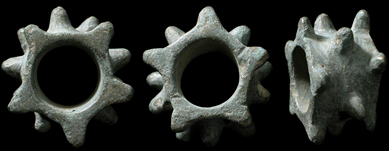
Roman bronze flagellum or scourge (Cat 'o' Nine Tails) punishment instrument. 1st-4th century AD. One piece from the end of a leather whip used to inflict punishment upon soldiers when they acted against orders. A fascinating piece of history. Barbs worn in antiquity, likely from extensive use. Found near a Legionary encampment bear the Danube River, Eastern Europe. 29x15 mm. Gorgeous green patina with earthen deposits. #AR2155: $450
SOLD - Another just came in! Ask to see photos!
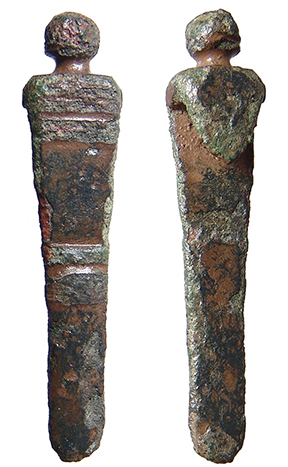 Roman Legionary bronze strap mount in the form of a gladius (Roman soldier's short, stabbing sword), circa 1st century AD. In the form of a sheathed sword, with rounded knob handle. A rare Roman depiction of a favored weapon of the time! L: 5.6 cm. Found in Arundel, UK. Ex Cheshire, UK private collection. #AR3410: $350
Roman Legionary bronze strap mount in the form of a gladius (Roman soldier's short, stabbing sword), circa 1st century AD. In the form of a sheathed sword, with rounded knob handle. A rare Roman depiction of a favored weapon of the time! L: 5.6 cm. Found in Arundel, UK. Ex Cheshire, UK private collection. #AR3410: $350
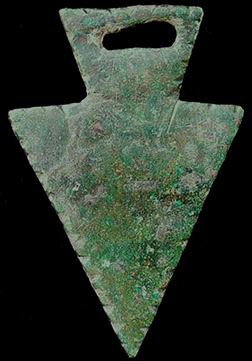 Rare Roman Legionary bronze harness pendant, c. 1st-2nd century AD. Made in the form of an arrowhead. Measures 42mm (1 5/8") long, with excellent green patina. Ref: Appels & Laycock, chapter 14; no exact parallels… This fascinating pendant is certainly of hand-made provincial or local manufacture, perhaps by the legion smithery or by a legionnaire himself. Ex Sandes collection, Southern California. #AR3435: $199
Rare Roman Legionary bronze harness pendant, c. 1st-2nd century AD. Made in the form of an arrowhead. Measures 42mm (1 5/8") long, with excellent green patina. Ref: Appels & Laycock, chapter 14; no exact parallels… This fascinating pendant is certainly of hand-made provincial or local manufacture, perhaps by the legion smithery or by a legionnaire himself. Ex Sandes collection, Southern California. #AR3435: $199
 Roman Legionary bronze strap mount in the form of a gladius (Roman soldier's short, stabbing sword), circa 1st century AD. In the form of a sheathed sword, with rounded knob handle. Originally with niello and silver inlay, some of it lost over the centuries. A rare Roman depiction of a favored weapon of the time! L: 3.5 cm (1 3/8"). ref: Bishop 5d for type. Ex Sandes collection, Southern California. #AR3439: $275
Roman Legionary bronze strap mount in the form of a gladius (Roman soldier's short, stabbing sword), circa 1st century AD. In the form of a sheathed sword, with rounded knob handle. Originally with niello and silver inlay, some of it lost over the centuries. A rare Roman depiction of a favored weapon of the time! L: 3.5 cm (1 3/8"). ref: Bishop 5d for type. Ex Sandes collection, Southern California. #AR3439: $275
Roman Coin Depicting a Legionary Galley!
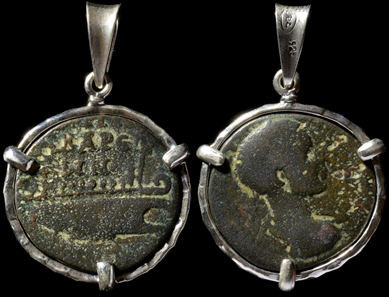 Roman Legionary Galley (Warship)!
Roman Legionary Galley (Warship)!
Ancient Rome. Gordian III, 238-244 AD. Large bronze coin of Gadara, Syria, set into stunning custom silver bezel.
Dated Year 303 239-240 AD). His laureate, draped, & cuirassed bust rt., AVTOK K M ANT GORDIANOC CEB / Roman galley (ship) right with eight oarsmen, a helmsman, and a soldier holding signum standing on prow; date GT below, POMP GADAWN. 27 mm diameter. ref: Spijkerman 93; Rosenberger 90. Olive green patina, earthen deposits. Huge, thick and heavy coin. Great ship! #CR2303: $275
See Also:
Marc Antony & Cleopatra Silver Coins
Depicting Legionary Galleys

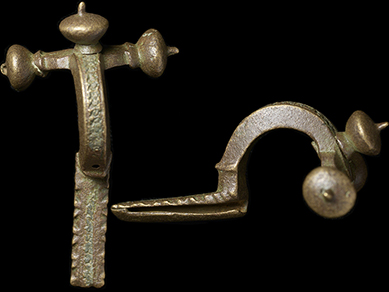 Roman, 3rd - 4th Century AD. Attractive bronze "Crossbow-fibula." Roman soldier's / Legionary type, with high arched body for thick material to fit through. Worn over the shoulder. Missing pin but with original terminals, nicely incised decoration along the back. L: 66mm (2 1/2"). Dark brassy tone, slightly bent in antiquity. A military-issued item, worn by high ranking figures in the legion. #AR2884: $199 SOLD - Ask about alternate! I have nicer ones.
Roman, 3rd - 4th Century AD. Attractive bronze "Crossbow-fibula." Roman soldier's / Legionary type, with high arched body for thick material to fit through. Worn over the shoulder. Missing pin but with original terminals, nicely incised decoration along the back. L: 66mm (2 1/2"). Dark brassy tone, slightly bent in antiquity. A military-issued item, worn by high ranking figures in the legion. #AR2884: $199 SOLD - Ask about alternate! I have nicer ones.
 Ancient Roman Legionary, c. 1st-3rd century AD. A rare bronze horse-shaped fibula. Exceptionally well-preserved, with its original pin! ref: Hattat #1185-1186 for type. Ex Northern California collection. #AR3543: $325 SOLD
Ancient Roman Legionary, c. 1st-3rd century AD. A rare bronze horse-shaped fibula. Exceptionally well-preserved, with its original pin! ref: Hattat #1185-1186 for type. Ex Northern California collection. #AR3543: $325 SOLD
|
Roman Gladius Amulets!
 Ancient Rome, 1st-3rd century AD. Excellent Roman bronze gladius / sword amulets. One of the most attractive and desirable ancient amulets. Issued to a soldier wounded in combat, much like a modern-day "purple heart" medal. The hole through the blade is representative of a hole in the body. "I may have a hole in my body but I shall fight on." Measure (left to right): 33mm, 30mm, 27mm. with olive-green patina, light earthen deposits. Cf. Benet R99-0104 for type. Better photos available on request. Ex Rönesans Salzgitter, Germany. #AR3553, #AR3554 & #AR3555: $275 each
Ancient Rome, 1st-3rd century AD. Excellent Roman bronze gladius / sword amulets. One of the most attractive and desirable ancient amulets. Issued to a soldier wounded in combat, much like a modern-day "purple heart" medal. The hole through the blade is representative of a hole in the body. "I may have a hole in my body but I shall fight on." Measure (left to right): 33mm, 30mm, 27mm. with olive-green patina, light earthen deposits. Cf. Benet R99-0104 for type. Better photos available on request. Ex Rönesans Salzgitter, Germany. #AR3553, #AR3554 & #AR3555: $275 each
* AR3555 SOLD, the other 2 available!
 Roman Legionary strap end, c. 1st - 4th Century AD. A Romano-British bronze military attachment, in the form of an amphora with band of lightly incised decoration. Original copper rivet still in place. 4.9 x 2 cm. ref: Appels & Laycock, Roman Buckles & Military Fittings, p. 251, fig. SL.13.12 for type. Found in Arundel, UK. Ex Cheshire, UK private collection. #AR3409: $225
Roman Legionary strap end, c. 1st - 4th Century AD. A Romano-British bronze military attachment, in the form of an amphora with band of lightly incised decoration. Original copper rivet still in place. 4.9 x 2 cm. ref: Appels & Laycock, Roman Buckles & Military Fittings, p. 251, fig. SL.13.12 for type. Found in Arundel, UK. Ex Cheshire, UK private collection. #AR3409: $225
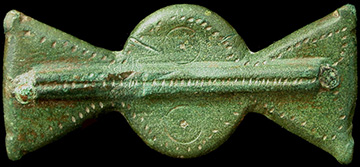 Roman Legionary, c. 4th century AD. An excellent Roman Legionary bronze propellor-type belt-mount. Quite a large example, hand-engraved with a circle and dot pattern (evil eye protective motif), with both attachment pins in place! The central bar to reinforce against sword and blunt-force trauma. Ref: Appels & Laycock, Roman Buckles & Military Fittings, p. 271, Fig. SL 14.18 for exact type (although the example offered here was actually hand engraved at the time). W: 45mm (1 3/4"). Ex Sandes collection, Southern California. #AR3436: $225
Roman Legionary, c. 4th century AD. An excellent Roman Legionary bronze propellor-type belt-mount. Quite a large example, hand-engraved with a circle and dot pattern (evil eye protective motif), with both attachment pins in place! The central bar to reinforce against sword and blunt-force trauma. Ref: Appels & Laycock, Roman Buckles & Military Fittings, p. 271, Fig. SL 14.18 for exact type (although the example offered here was actually hand engraved at the time). W: 45mm (1 3/4"). Ex Sandes collection, Southern California. #AR3436: $225
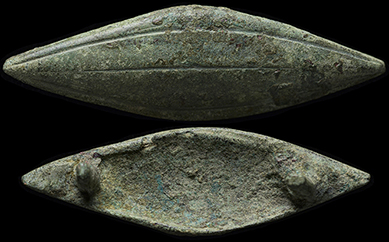 Roman Legionary bronze belt stiffener, c. 1st-2nd century AD. Lenticular in shape, the curved top surface engraved with three long lines, the original attachment nubs still intact on the back. Olive-green patina with earthen and mineral deposits. L: 52mm (2 inches). From the estate of Robert Flourance, Virginia. #AR3220G1: $125
Roman Legionary bronze belt stiffener, c. 1st-2nd century AD. Lenticular in shape, the curved top surface engraved with three long lines, the original attachment nubs still intact on the back. Olive-green patina with earthen and mineral deposits. L: 52mm (2 inches). From the estate of Robert Flourance, Virginia. #AR3220G1: $125
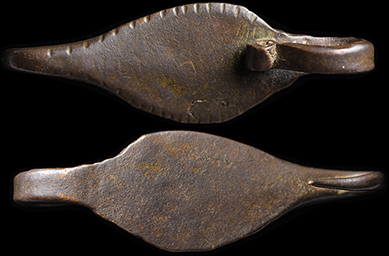 Roman cavalry harness pendant, c. 1st-2nd century AD. "Long Drop" type. Extremely well-preserved with excellent surfaces, etched line design around the edge, the hook still very sharp! L: 44mm (1 5/8"). From the estate of Robert Flourance, Virginia. #AR3220G6: $150
Roman cavalry harness pendant, c. 1st-2nd century AD. "Long Drop" type. Extremely well-preserved with excellent surfaces, etched line design around the edge, the hook still very sharp! L: 44mm (1 5/8"). From the estate of Robert Flourance, Virginia. #AR3220G6: $150
 Roman Legionary, c. 4th century AD. A nice Roman Legionary bronze propellor-type belt-mount. Nicely hand-engraved; the round central boss engraved with concentric rings, circle-and-dot patterns to either side (evil eye protective motif). Two rivet holes classic to the type. W: 29mm (1 1/8"). Dark green patina with earthen deposits. Ref: Appels & Laycock, Roman Buckles & Military Fittings, p. 272, Fig. SL 14.22 for type. Ex Sandes collection, Southern California. #AR3438: $150
Roman Legionary, c. 4th century AD. A nice Roman Legionary bronze propellor-type belt-mount. Nicely hand-engraved; the round central boss engraved with concentric rings, circle-and-dot patterns to either side (evil eye protective motif). Two rivet holes classic to the type. W: 29mm (1 1/8"). Dark green patina with earthen deposits. Ref: Appels & Laycock, Roman Buckles & Military Fittings, p. 272, Fig. SL 14.22 for type. Ex Sandes collection, Southern California. #AR3438: $150
 Roman Legionary, c. 4th century AD. Nice Roman Legionary bronze propellor-type belt-mount. Nicely preserved, with both attachment rived holes intact! The central bar to reinforce against sword and blunt-force trauma. Ref: Appels & Laycock, Roman Buckles & Military Fittings, p. 271, Fig. SL 14.18-var. for type. W: 42mm (just under 1 3/4"). Excellent light green patina. From the Estate of Robert Flourance, Virginia. #AR3220G3: $175
Roman Legionary, c. 4th century AD. Nice Roman Legionary bronze propellor-type belt-mount. Nicely preserved, with both attachment rived holes intact! The central bar to reinforce against sword and blunt-force trauma. Ref: Appels & Laycock, Roman Buckles & Military Fittings, p. 271, Fig. SL 14.18-var. for type. W: 42mm (just under 1 3/4"). Excellent light green patina. From the Estate of Robert Flourance, Virginia. #AR3220G3: $175
 Roman Legionary, c. 4th century AD. Nice Roman Legionary bronze propellor-type belt-mount. Big and heavy, with attachment pins in place! The central bar to reinforce against sword and blunt-force trauma. Ref: Appels & Laycock, Roman Buckles & Military Fittings, p. 271, Fig. SL 14.18 for exact type. W: 48mm (1 7/8"). Olive-green patina with earthen and mineral deposits. From the Estate of Robert Flourance, Virginia. #AR3220G4: $199
Roman Legionary, c. 4th century AD. Nice Roman Legionary bronze propellor-type belt-mount. Big and heavy, with attachment pins in place! The central bar to reinforce against sword and blunt-force trauma. Ref: Appels & Laycock, Roman Buckles & Military Fittings, p. 271, Fig. SL 14.18 for exact type. W: 48mm (1 7/8"). Olive-green patina with earthen and mineral deposits. From the Estate of Robert Flourance, Virginia. #AR3220G4: $199
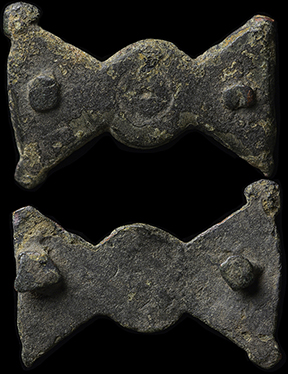 Roman Legionary, c. 4th century AD. Nice Roman Legionary bronze propellor-type belt-mount. Nicely preserved, with attachment pins still in place! Ref: Appels & Laycock, Roman Buckles & Military Fittings, p. 270, Fig. SL14.13 for exact type. W: 27mm (1 1/16"). Deep olive-green patina with earthen and mineral deposits. From the Estate of Robert Flourance, Virginia. #AR3220G5: $150
Roman Legionary, c. 4th century AD. Nice Roman Legionary bronze propellor-type belt-mount. Nicely preserved, with attachment pins still in place! Ref: Appels & Laycock, Roman Buckles & Military Fittings, p. 270, Fig. SL14.13 for exact type. W: 27mm (1 1/16"). Deep olive-green patina with earthen and mineral deposits. From the Estate of Robert Flourance, Virginia. #AR3220G5: $150
|
|
|
|
|
Every item comes with a 100% Lifetime Guarantee of Authenticity.
To make a purchase, or for more information, CLICK HERE
|
|
All contents (C) 2003-2025 AD. All rights reserved.
Owned, Operated, and Obsessed Upon by Gabriel Vandervort.
Reproduction without permission is prohibited.
|
|
Related search topics: ancient Roman war artifacts, ancient Rome military, Roman military artifacts for sale, Roman military camp artifacts, Roman battlefield relic, Rome battle artifact, ancient Roman soldier artifact, Roman soldiers artifacts for sale, Roman legion relics, ancient Roman legionary antiques antiquity, Los Angeles California USA
|
|
|
|
|
Ancient Rome, c. 2nd century AD. Italica Legion clay brick
Absolutely MASSIVE Roman ceramic brick stamped with "LEG I ITAL" in reverse, made by the Italica legion under Trajan at Olpia Oescus on the lower Danube (one of Trajan's strategic bases prior to the second invasion of Dacia in 106 AD). Measures 200 mm x 195 mm and extremely thick and heavy! A fantastic piece. ref: Speidel & Reynolds. Ex-Timeline Auctions, London, England. #TL1771: $799 SOLD
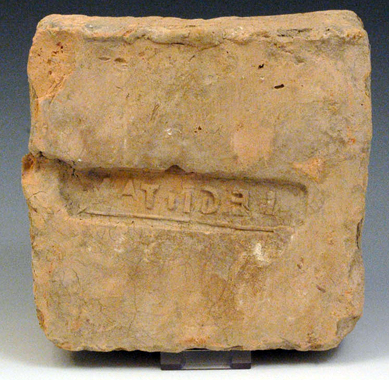
Roman bronze lorica segmentata. 1st-2nd century AD. A fully articulated Lorica Segmentata strap buckle for Corbridge armor... the earliest Roman form of segmented plate armor. Completely intact with the original front rivet still holding the pin and loop together, which still move freely. 53 mm (2 1/8") long. Gorgeous olive green patina. A great and historical piece! #7102: $325 SOLD

Excellent Roman bronze figure of Mars, 2nd - 3rd Century AD. Found in the Holy Land! He is shown wearing full Roman legionary attire and crested helmet, left hand at his side clenching an uncertain object, right resting on spear (now lost). Some losses to feet and legs. H: 2 1/4" (5.8 cm). Ex Canadian private collection. Very very cool. #0611129x3: $375 SOLD
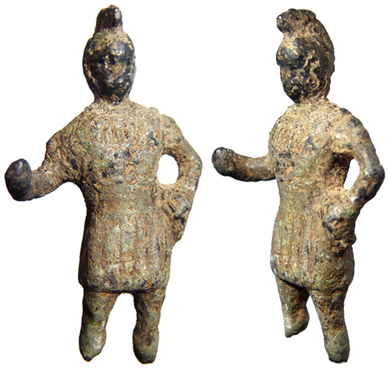
A near complete terracotta brick bearing the stamp of Roman Legion I Italica, c. 1st - 2nd Century AD, which was stationed in what is today Svishtov, Bulgaria. The rectangular stamp bears the letters LEG I ITAL within a shallow border. The face of the brick is intact with earthen deposits, the back side with a few chips and minor losses. 7 3/8" x 7 1/4" x 3 1/4" (18.8 x 18.4 x 8.3 cm). A very substantial piece! #80033: $699 SOLD
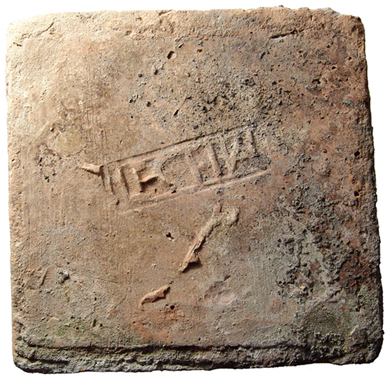
|
Roman bronze cheek-piece from a legionary helmet, c. 2nd - 3rd century AD. Made of a repousse rectangular bronze plaque featuring the helmeted facing bust of Athena. Deep relief, beautiful olive-green patina. 80x48 mm (3 1/8 x 1 78"). Remarkable! #27106: $450 Roman Legionary Bricks & TilesSOLD
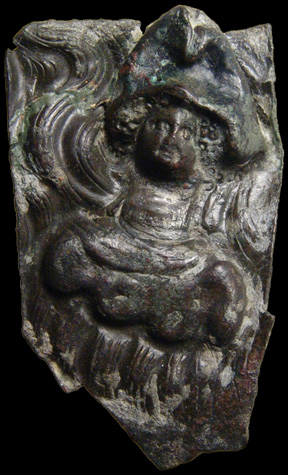
Ancient Rome, c. 2nd century AD. Italica Legion clay brick.
Huge Roman ceramic brick stamped with "LEG I ITALI [spade]", made by the Italica legion under Trajan at Olpia Oescus on the lower Danube (one of Trajan's strategic bases prior to the second invasion of Dacia in 106 AD). Measures 271 mm x 128 mm (10 3/4" x 5") and extremely thick and heavy! A fantastic piece, repaired from 2 pieces, otherwise intact with some chipping to edges. ref: Speidel & Reynolds (var). An extremely rare variant with the spade. #AR2371: $750 SOLD
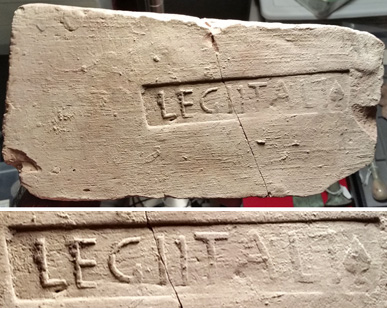
Ancient Roman terracotta brick, 1st - 2nd Century AD.
A Legionary piece, impressed with stamp of the Legio I Italica! The impression is within a naval galley / warship. The stamp impression is a bit weak to the right side, but the brick is complete and quite substantial. 7 3/4" x 7 5/8" x 3 1/4" (19.5 x 19.4 x 7.8 cm). Legio I Italica was founded by the emperor Nero in AD 66. They were originally stationed in Gaul and were later relocated to the town of Novea, on the south bank of the Danube in Moesia Inferior. Fantastic and huge piece. Ex English collection. #BL0910168: $650 SOLD
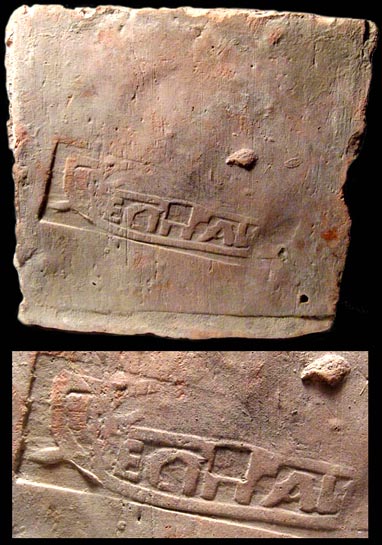
Roman terracotta brick with stamp of Legio III Augusta, 1st - 2nd Century AD. The brick itself with some losses, but the long rectangular stamp is nearly complete. 5" x 4 1/2" (12.8 x 11.4 cm). Ex Los Angeles private collection. Displays nicely... better than photo. #A14110: $350 SOLD
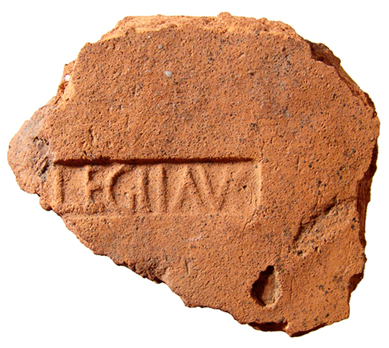
|
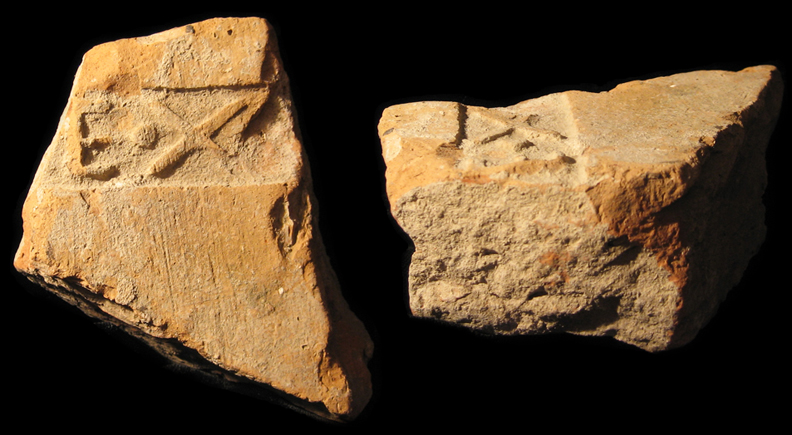
A very nice and HUGE terracotta brick bearing the stamp of the Roman Legion I Italia, c. 1st - 2nd Century AD, which was stationed in what is today Svishtov, Bulgaria. The rectangular impression bears the inscription LEG I ITAL within a rectangular bar. The brick is well preserved with some minor chipping and earthen deposits. 7 1/2" x 7 3/4" x 3 1/4" (19.2 x 19.7 x 8.3 cm). A nice and massive example! #80034: $699 SOLD
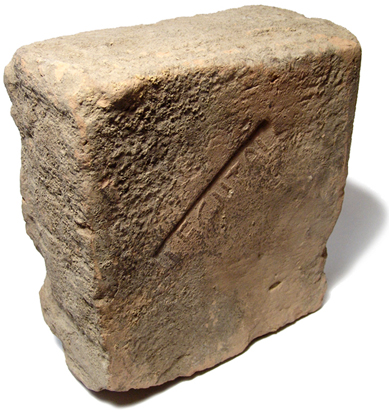
Roman terracotta brick stamped with LEG XII within a rectangular impression, c. 1st - 2nd Century AD. The LEG XII referred to is the Legion XII Fulminata, with its main base in Asia Minor. Two of the original sides remain in part, with some minor loss to the right edge of the impression. Earthen deposits. 6 3/4" x 7 3/4" x 7/8" (17.2 x 19.7 x 2.2 cm). The Roman Legion was not only a fighting force but also contained a work force of support groups that maintained the troops and built and repaired the infrastructure needed to keep the men comfortable, housed and able to move quickly when needed. #80032: $475 SOLD
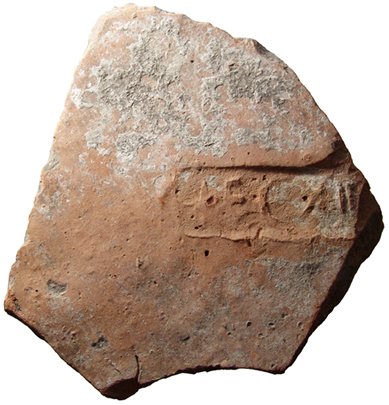
Ancient Rome, c. 2nd-3rd century AD. A fantastic bronze military/Legionary diploma fragment. A beautiful piece, with Latin inscriptions clearly visible on both sides. Found at an ancient site in former Thrace/Macedonia. A military diploma was a permanent document issued by Rome to a soldier or praetorian upon retirement, which detailed his service and the various rights now granted to him. This document would have been the single most important item to a retired Roman soldier! Dia: 30 mm (1 1/8"). Gorgeous olive-green patina. Some very crisp inscriptions. ex-Los Angeles, CA collection. #AR2176: $599 SOLD

Roman Holy Land. Bronze flagellum or scourge (Cat 'o' Nine Tails) punishment instrument. 1st-4th century AD. One piece from the end of a leather whip used to inflict punishment upon soldiers when they acted against orders. A fascinating piece of history. Barbs worn from extensive use. Found in the Holy Land. 26 mm (1 inch) diameter, with dark olive-green patina and some earthen deposits. The best I have ever had! #AR2165: $475 SOLD
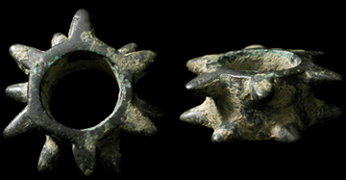
Ancient Rome, 1st-4th century AD. A nice fragment of a Roman terracotta brick with a legionary stamp "E-X". Measures 4x3 inches, and is chunky at 1 3/8 inch thick. Great piece with sharp detail! #5866: $350 SOLD
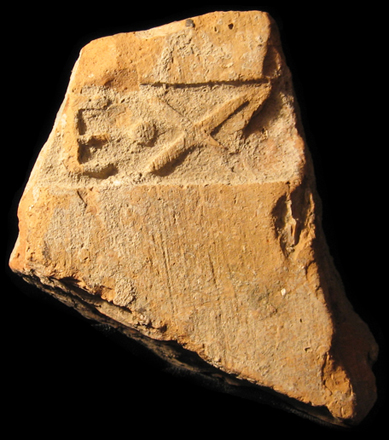
Roman Empire, c. 2nd-4th century AD. Large iron spike, found at the remains of a Roman Legionary encampment near the Danube River in Eastern Europe. Absolutely massive 185 mm (7 /4") long and thick and heavy! This was the type of nail used to hold together large pieces of lumber in timber-frame frontier fortress walls and buildings. Remarkably well-preserved for ancient iron! #51132: $250 SOLD

Inchtuthil, Roman Britain, 82-83 AD. A nice iron nail recovered from the Roman Legionary fortress at Inchtuthil northern Britain.
Built beginning around 82 AD as the headquarters for the army of governor Agricola during his military campaign against the Caledonian tribes. The site was excavated in the 1950's and tons of iron nails were discovered. Many of these were sold to raise funds for further excavations on the site, including this example offered here. It measures 90 mm (3 1/2") long and is remarkably well-preserved. #AR2175: $199 SOLD

 Ancient Rome, c. mid-3rd century AD. Large bronze plaque. An incredibly rare 2-sided bronze fragment engraved on both sides with a deep-cut inscription reading:
Ancient Rome, c. mid-3rd century AD. Large bronze plaque. An incredibly rare 2-sided bronze fragment engraved on both sides with a deep-cut inscription reading:
Side A: VIII.VIIII.X.PI / VINDICIBVS / MILITIA - PVI
Side B: IMP CAES.G / IVLIVS VERVS / MAXIMINVS
Likely a Roman legionary inscription hailing the emperor Maximinus, 235-238 AD, probably originally from the Roman province of Pannonia. 72 x 36 mm (2 13/16” x 1 7/16”), incredibly thick and heavy at 52.42 grams! Broken off on one side, with deep olive-green patina and earthen deposits. Provenance: The European antiquities market; ex-Edgar L. Owen. #AR2335: $650 SOLD
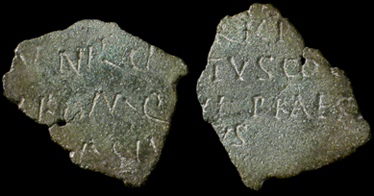 Very rare Roman military diploma fragment. From the Roman Province of Pannonia, c. 3rd-4th century AD. The small bronze fragment clearly inscribed in Latin on both sides, reading:
Very rare Roman military diploma fragment. From the Roman Province of Pannonia, c. 3rd-4th century AD. The small bronze fragment clearly inscribed in Latin on both sides, reading:
Side A: M NRCI / ROMC / ACM
Side B: RMI / TVSCO / MI PRAES / VS
20 x 25 mm. Very rare. Excellent smooth green patina. Roman legionary diplomas were given to retiring legionary soldiers by the Roman military authorities to certify their years of legionary service, often with the gift of property in a Roman Colonia. They were often broken into smaller and smaller fragments and the pieces distributed among the male descendants to prove their heritage. Provenance: From an old Hungarian collection formed in the 1960's. Definitely the nicest specimen I have ever had. #AR2321: $650 SOLD
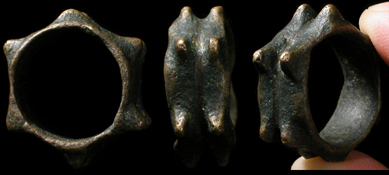 Ancient Roman Legionnaire's Brass Knuckles!
Ancient Roman Legionnaire's Brass Knuckles!
Ancient Rome, c. 1st-3rd century AD. Also called a "punch-ring", it is a spiked/knobbed bronze ring worn to intensify a punch during hand-to-hand combat. Very rare and extremely well-preserved. Can still be worn! About a US size 7 1/2 to 8. ex-Bedford, England private collection. #AR2328: $425 SOLD
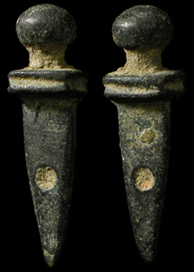 Ancient Rome, 1st-3rd century AD. Roman bronze gladius / sword amulet. One of the most attractive and desirable ancient amulets. Issued to a soldier wounded in combat, much like a modern-day "purple heart" medal. The hole through the blade is representitive of a hole in the body. "I may have a hole in my body but I shall fight on." 35 mm (1 3/8") with great deep green patina with light earthen deposits. Cf. Benet R99-0104. ex-German private collection. #AR2286: $375 SOLD
Ancient Rome, 1st-3rd century AD. Roman bronze gladius / sword amulet. One of the most attractive and desirable ancient amulets. Issued to a soldier wounded in combat, much like a modern-day "purple heart" medal. The hole through the blade is representitive of a hole in the body. "I may have a hole in my body but I shall fight on." 35 mm (1 3/8") with great deep green patina with light earthen deposits. Cf. Benet R99-0104. ex-German private collection. #AR2286: $375 SOLD
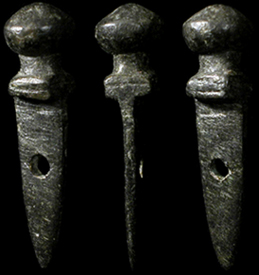
Ancient Rome, 1st-3rd century AD. Large Roman bronze gladius / sword amulet. One of the most attractive and desirable ancient amulets. Issued to a soldier wounded in combat, much like a modern-day "purple heart" medal. The hole through the blade is representitive of a hole in the body. "I may have a hole in my body but I shall fight on." 38 mm (1 1/2") with great black patina. Cf. Benet R99-0104. ex-Austrian private collection. #AR2548: $375 SOLD
 Ancient Rome. Gordian III, 238-244 AD. Large bronze coin of Gadara, Syria, set into stunning custom silver bezel.
Ancient Rome. Gordian III, 238-244 AD. Large bronze coin of Gadara, Syria, set into stunning custom silver bezel.
Dated Year 303 239-240 AD). His laureate, draped, & cuirassed bust rt., AVTOK K M ANT GORDIANOC CEB / Roman galley (ship) right with eight oarsmen, a helmsman, and a soldier holding signum standing on prow; date GT below, POMP GADAWN. 26 mm diameter. ref: Spijkerman 93; Rosenberger 90. Olive green patina, earthen deposits. Huge, thick and heavy coin. Incredible ship! #CR2300: $325 SOLD - Ask about alternates!
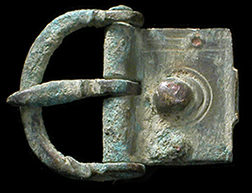 Roman bronze lorica segmentata. 1st-2nd century AD. A nicely articulated Lorica Segmentata strap buckle for Corbridge armor... the earliest Roman form of segmented plate armor. Intact with the original front rivet still holding the pin and loop together, which still move freely. 25 mm (1 inch) long. Nice olive green patina with earthen deposits. ex-UK collection. #AR2566: $199 SOLD
Roman bronze lorica segmentata. 1st-2nd century AD. A nicely articulated Lorica Segmentata strap buckle for Corbridge armor... the earliest Roman form of segmented plate armor. Intact with the original front rivet still holding the pin and loop together, which still move freely. 25 mm (1 inch) long. Nice olive green patina with earthen deposits. ex-UK collection. #AR2566: $199 SOLD

Ancient Rome, c. 2nd-3rd century AD. Fantastic and absolutely huge bronze military diploma fragment. Both sides covered with Latin inscriptions commemorating a soldier or Legionaire's completion of his military duties. Measures a whopping 77 mm (3 inches) by 53 mm (2 1/8 inches) - several times larger than these are usually found. ex-Abell auctions, Los Angeles, CA. A museum-quality example! #AR2728: $1250 SOLD
 Ancient Rome, 1st-3rd century AD. Nice Roman bronze gladius / sword amulet. One of the most attractive and desirable ancient amulets. Issued to a soldier wounded in combat, much like a modern-day "purple heart" medal. The hole in the blade is representitive of a hole in the body. "I may have a hole in my body but I shall fight on." 37 mm (1 7/16") with olive-green patina. Cf. Benet R99-0104. ex-London, UK gallery. #AR2770: $299 SOLD
Ancient Rome, 1st-3rd century AD. Nice Roman bronze gladius / sword amulet. One of the most attractive and desirable ancient amulets. Issued to a soldier wounded in combat, much like a modern-day "purple heart" medal. The hole in the blade is representitive of a hole in the body. "I may have a hole in my body but I shall fight on." 37 mm (1 7/16") with olive-green patina. Cf. Benet R99-0104. ex-London, UK gallery. #AR2770: $299 SOLD
 Ancient Rome, 1st-3rd century AD. Small Roman bronze gladius / sword amulet. One of the most attractive and desirable ancient amulets. Issued to a soldier wounded in combat, much like a modern-day "purple heart" medal. The hole in the blade is representitive of a hole in the body. "I may have a hole in my body but I shall fight on." 35 mm (1 3/8") with light olive-green patina. Cf. Benet R99-0104. ex-London, UK gallery. #AR2794: $250 SOLD
Ancient Rome, 1st-3rd century AD. Small Roman bronze gladius / sword amulet. One of the most attractive and desirable ancient amulets. Issued to a soldier wounded in combat, much like a modern-day "purple heart" medal. The hole in the blade is representitive of a hole in the body. "I may have a hole in my body but I shall fight on." 35 mm (1 3/8") with light olive-green patina. Cf. Benet R99-0104. ex-London, UK gallery. #AR2794: $250 SOLD
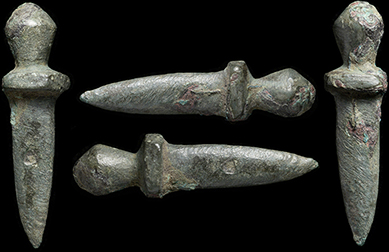
Ancient Rome, 1st-3rd century AD. Small Roman bronze gladius / sword amulet. One of the most attractive and desirable ancient amulets. Issued to a soldier wounded in combat, much like a modern-day "purple heart" medal. The hole in the blade is representitive of a hole in the body. "I may have a hole in my body but I shall fight on." 28 mm (1 1/8") with light olive-green patina. Cf. Benet R99-0104. ex-London, UK gallery. #AR2799: $250 SOLD
Roman Legionary Diploma Fragments
The most valuable possession of a retired Roman soldier!
These were intentionally broken into pieces and distributed so that they could not be easily found and pieced back together, thereby making permanent the individual's status and ineligibility to be re-drafted into service.
 Ancient Rome, c. 2nd-3rd century AD. Fantastic and absolutely huge bronze military diploma fragment. 2 pieces broken from the same document! Both sides covered with Latin inscriptions commemorating a soldier or Legionaire's completion of his military duties. The largest piece measures 67x55 mm (2 5/8" x 2 1/8"), the smaller piece 42x45 mm (1 3/4" x 1 5/8") - several times larger than these are usually found, and thick and heavy. Very rare to find 2 matched pieces! ex-Abell auctions, Los Angeles, CA. A museum-quality example! #AR2740: $550 SOLD
Ancient Rome, c. 2nd-3rd century AD. Fantastic and absolutely huge bronze military diploma fragment. 2 pieces broken from the same document! Both sides covered with Latin inscriptions commemorating a soldier or Legionaire's completion of his military duties. The largest piece measures 67x55 mm (2 5/8" x 2 1/8"), the smaller piece 42x45 mm (1 3/4" x 1 5/8") - several times larger than these are usually found, and thick and heavy. Very rare to find 2 matched pieces! ex-Abell auctions, Los Angeles, CA. A museum-quality example! #AR2740: $550 SOLD
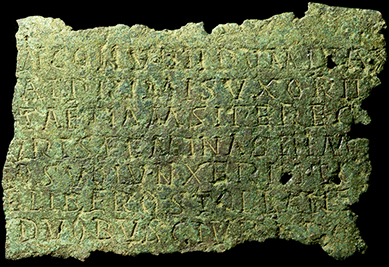 Ancient Rome, c. 2nd-3rd century AD. Fantastic and absolutely huge bronze military diploma fragment. Both sides covered with Latin inscriptions commemorating a soldier or Legionaire's completion of his military duties. Measures a huge 75 mm (2-15/16 inches) by 50 mm (2 inches) - several times larger than these are usually found. ex-Abell auctions, Los Angeles, CA. A museum-quality example! #AR2739: $650 SOLD
Ancient Rome, c. 2nd-3rd century AD. Fantastic and absolutely huge bronze military diploma fragment. Both sides covered with Latin inscriptions commemorating a soldier or Legionaire's completion of his military duties. Measures a huge 75 mm (2-15/16 inches) by 50 mm (2 inches) - several times larger than these are usually found. ex-Abell auctions, Los Angeles, CA. A museum-quality example! #AR2739: $650 SOLD
 Ancient Rome, c. 2nd-3rd century AD. Fantastic and absolutely huge bronze military diploma fragment. Both sides covered with Latin inscriptions commemorating a soldier or Legionaire's completion of his military duties. Measures a whopping 89 mm (3 1/2 inches) by 44 mm (1 3/4 inches) - several times larger than these are usually found. ex-Abell auctions, Los Angeles, CA. A museum-quality example! #AR2738: $650 SOLD
Ancient Rome, c. 2nd-3rd century AD. Fantastic and absolutely huge bronze military diploma fragment. Both sides covered with Latin inscriptions commemorating a soldier or Legionaire's completion of his military duties. Measures a whopping 89 mm (3 1/2 inches) by 44 mm (1 3/4 inches) - several times larger than these are usually found. ex-Abell auctions, Los Angeles, CA. A museum-quality example! #AR2738: $650 SOLD
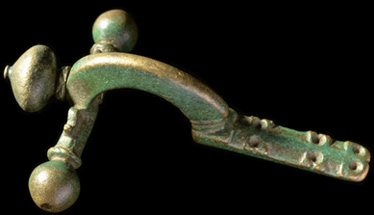
Roman, 3rd - 4th Century AD. Large bronze "Crossbow-fibula." Roman soldier's / Legionary type, with high arched body for thick material to fit through. Worn over the shoulder. Missing pin but with original terminals, gorgeous brassy-green patina. A hefty 77 mm (3 inches) long. A military-issued item, worn by high ranking figures in the legion. #AR2534: $175 SOLD - Ask about alternates
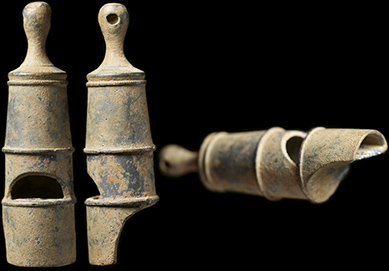 Ancient Rome, c. 1st-3rd century AD. Fantastic lead military / legionary whistle! The exact use of whistles such as this is debated amongst scholars but the general consensus is that they were used my officers to broadcast commands on the battlefield or for training purposes. ref: Appels & Laycock, Roman Buckles & Military Fittings, p. 146 fig. AA15.41 for basic type. L: 5cm (2"), gray patina with earthen deposits. Holed through top for suspension. Still works! Emits a high-pitched sound when blown through. Extraordinarily well-preserved for these. Ex-Los Angeles, CA private collection. #AR2952: $399 SOLD
Ancient Rome, c. 1st-3rd century AD. Fantastic lead military / legionary whistle! The exact use of whistles such as this is debated amongst scholars but the general consensus is that they were used my officers to broadcast commands on the battlefield or for training purposes. ref: Appels & Laycock, Roman Buckles & Military Fittings, p. 146 fig. AA15.41 for basic type. L: 5cm (2"), gray patina with earthen deposits. Holed through top for suspension. Still works! Emits a high-pitched sound when blown through. Extraordinarily well-preserved for these. Ex-Los Angeles, CA private collection. #AR2952: $399 SOLD
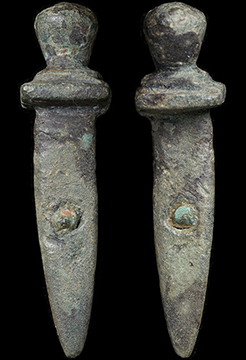 Ancient Rome, 1st-3rd century AD. Small Roman bronze gladius / sword amulet. One of the most attractive and desirable ancient amulets. Issued to a soldier wounded in combat, much like a modern-day "purple heart" medal. The hole in the blade is representitive of a hole in the body. "I may have a hole in my body but I shall fight on." Extremely RARE with original lead plug in the hole! 32 mm (1 1/4") with light olive-green patina. Cf. Benet R99-0104. ex-London, UK gallery. #AR2800: $299 SOLD
Ancient Rome, 1st-3rd century AD. Small Roman bronze gladius / sword amulet. One of the most attractive and desirable ancient amulets. Issued to a soldier wounded in combat, much like a modern-day "purple heart" medal. The hole in the blade is representitive of a hole in the body. "I may have a hole in my body but I shall fight on." Extremely RARE with original lead plug in the hole! 32 mm (1 1/4") with light olive-green patina. Cf. Benet R99-0104. ex-London, UK gallery. #AR2800: $299 SOLD
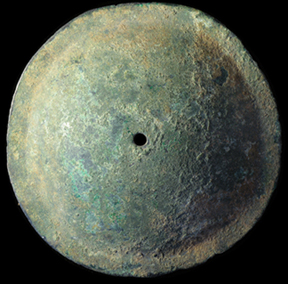 Ancient Rome, c. 1st-4th century AD. Marvelous bronze shield boss! Also known as an umbo. Measures 2 3/4" (7 cm), with small attachment rivet hole in center. Cf. Appels & Laycock AA7.4v. Light olive-green patina with earthen and mineral deposits.
Ancient Rome, c. 1st-4th century AD. Marvelous bronze shield boss! Also known as an umbo. Measures 2 3/4" (7 cm), with small attachment rivet hole in center. Cf. Appels & Laycock AA7.4v. Light olive-green patina with earthen and mineral deposits.
ex-J. Rilling collection, Orange County, CA. #AR2395: $325 SOLD
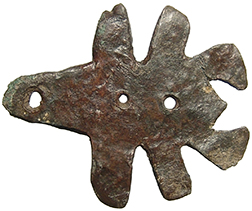 Ancient Rome, c. 1st - 3rd Century AD. Interesting Roman lead element in the form of a scorpion. Likely a legionary or military adornment, fashioned from a sheet of lead with eight legs represented by two per side with shortened tail and claws; three holes down the center, largest at tail likely for suspension. L: 1 3/4” (4.3cm). Nice grey-brown patina. Ex New Jersey estate collection. #AR3101: $225 SOLD
Ancient Rome, c. 1st - 3rd Century AD. Interesting Roman lead element in the form of a scorpion. Likely a legionary or military adornment, fashioned from a sheet of lead with eight legs represented by two per side with shortened tail and claws; three holes down the center, largest at tail likely for suspension. L: 1 3/4” (4.3cm). Nice grey-brown patina. Ex New Jersey estate collection. #AR3101: $225 SOLD
 Ancient Rome, 1st-3rd century AD. Small Roman bronze gladius / sword amulet. One of the most attractive and desirable ancient amulets. Issued to a soldier wounded in combat, much like a modern-day "purple heart" medal. L: 37 mm (1 7/16") with dark olive-green patina. Cf. Benet R99-0104. Ex South London private collection; acquired between 1970-1980. #AR3119: SOLD
Ancient Rome, 1st-3rd century AD. Small Roman bronze gladius / sword amulet. One of the most attractive and desirable ancient amulets. Issued to a soldier wounded in combat, much like a modern-day "purple heart" medal. L: 37 mm (1 7/16") with dark olive-green patina. Cf. Benet R99-0104. Ex South London private collection; acquired between 1970-1980. #AR3119: SOLD
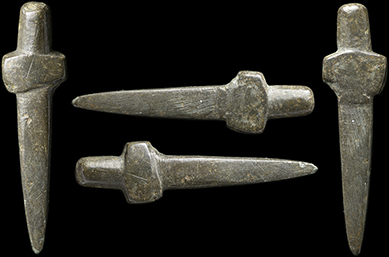 Ancient Rome, 1st-3rd century AD. Small Roman bronze gladius / sword amulet. One of the most attractive and desirable ancient amulets. Issued to a soldier wounded in combat, much like a modern-day "purple heart" medal. L: 37 mm (1 7/16") with dark olive-green patina. Cf. Benet R99-0104. Ex South London private collection; acquired between 1970-1980. #AR3120: $199 SOLD
Ancient Rome, 1st-3rd century AD. Small Roman bronze gladius / sword amulet. One of the most attractive and desirable ancient amulets. Issued to a soldier wounded in combat, much like a modern-day "purple heart" medal. L: 37 mm (1 7/16") with dark olive-green patina. Cf. Benet R99-0104. Ex South London private collection; acquired between 1970-1980. #AR3120: $199 SOLD
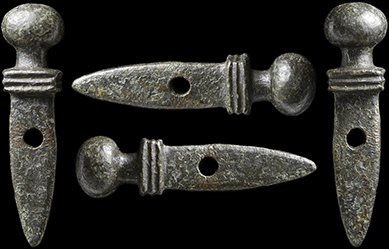 Ancient Rome, 1st-3rd century AD. Small Roman bronze gladius / sword amulet. One of the most attractive and desirable ancient amulets. Issued to a soldier wounded in combat, much like a modern-day "purple heart" medal. The hole in the blade is representitive of a hole in the body. "I may have a hole in my body but I shall fight on." 35 mm (1 3/8") with dark olive-green patina. Cf. Benet R99-0104. Ex South London private collection; acquired between 1970-1980. Fantastic example! #AR3118: $375 SOLD
Ancient Rome, 1st-3rd century AD. Small Roman bronze gladius / sword amulet. One of the most attractive and desirable ancient amulets. Issued to a soldier wounded in combat, much like a modern-day "purple heart" medal. The hole in the blade is representitive of a hole in the body. "I may have a hole in my body but I shall fight on." 35 mm (1 3/8") with dark olive-green patina. Cf. Benet R99-0104. Ex South London private collection; acquired between 1970-1980. Fantastic example! #AR3118: $375 SOLD
Roman Gladius Amulets!
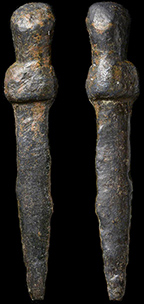 Ancient Rome, 1st-3rd century AD. Nice Roman bronze gladius / sword amulet. One of the most desirable ancient Roman military amulets. Long, slender form with rounded pommel. 38 mm (1 1/2") with black patina, light earthen deposits. Cf. Benet R99-0104. ex-London, UK gallery. #AR2782: $199 SOLD
Ancient Rome, 1st-3rd century AD. Nice Roman bronze gladius / sword amulet. One of the most desirable ancient Roman military amulets. Long, slender form with rounded pommel. 38 mm (1 1/2") with black patina, light earthen deposits. Cf. Benet R99-0104. ex-London, UK gallery. #AR2782: $199 SOLD
Roman Legionnaire's Ring!
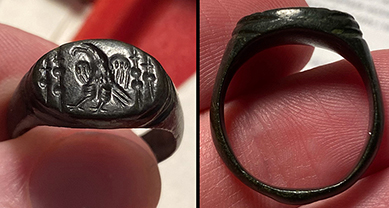 Ancient Roman, 1st-2nd century AD. Absolutely museum quality Legionnaire's ring, depicting an eagle between four military standards. US size 7 1/4. Possibly the most beautiful Roman ring I've ever had. Excellent glossy deep olive-green, almost black patina. ref: T.N. Polio, "Ancient Rings" p. 73 for type. Ex Northern California private collection. Every ancient “signet” or “seal” ring was unique and could pass as a "signet" (where we get our word "signature" into clay or wax seals on documents. #JR2425: $550 SOLD
Ancient Roman, 1st-2nd century AD. Absolutely museum quality Legionnaire's ring, depicting an eagle between four military standards. US size 7 1/4. Possibly the most beautiful Roman ring I've ever had. Excellent glossy deep olive-green, almost black patina. ref: T.N. Polio, "Ancient Rings" p. 73 for type. Ex Northern California private collection. Every ancient “signet” or “seal” ring was unique and could pass as a "signet" (where we get our word "signature" into clay or wax seals on documents. #JR2425: $550 SOLD
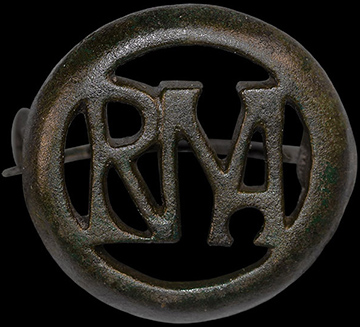 Ancient Roman Legionary phalera brooch, c. 2nd century AD, reading "ROMA" in monogram form. A bronze discoid plate brooch with openwork monogram of 'ROMA', hinged pin and catchplate to the reverse. 32mm (1 1/4") diameter. Extremely fine condition with lustrous green patina. See Appels & Laycock, Roman Buckles & Military Fittings, chapter 9 for general type. Provenance: From the collection of a European gentleman living in South London; acquired 1970-1980; Ex London, UK gallery. #AR3112: $650 SOLD
Ancient Roman Legionary phalera brooch, c. 2nd century AD, reading "ROMA" in monogram form. A bronze discoid plate brooch with openwork monogram of 'ROMA', hinged pin and catchplate to the reverse. 32mm (1 1/4") diameter. Extremely fine condition with lustrous green patina. See Appels & Laycock, Roman Buckles & Military Fittings, chapter 9 for general type. Provenance: From the collection of a European gentleman living in South London; acquired 1970-1980; Ex London, UK gallery. #AR3112: $650 SOLD
 Roman Legionary Galley (Warship)!
Roman Legionary Galley (Warship)!
Gordian III, 238-244 AD. Large bronze coin of Gadara, Syria.
Dated Year 303 239-240 AD). His laureate, draped, & cuirassed bust rt., AVTOK K M ANT GORDIANOC CEB / Roman galley (ship) right with eight oarsmen, a helmsman, and a soldier holding signum standing on prow; date GT below, POMP GADAWN. 25 mm, 12.16 g. ref: Spijkerman 93; Rosenberger 90. Reddish-green patina, earthen deposits. Nice ship depiction... much better than the photo allows. #CR2301: $125 SOLD
 Gordian III, 238-244 AD. Large bronze coin of Gadara, Syria.
Gordian III, 238-244 AD. Large bronze coin of Gadara, Syria.
Dated Year 303 239-240 AD). His laureate, draped, & cuirassed bust rt., AVTOK K M ANT GORDIANOC CEB / Roman galley (ship) right with eight oarsmen, a helmsman, and a soldier holding signum standing on prow; date GT below, POMP GADAWN. 26 mm, 16.45 g. ref: Spijkerman 93; Rosenberger 90. Olive green patina, earthen deposits. Huge, thick and heavy coin. Incredible ship! This coin is a beauty... much better than the photo. #CR2304: $199 SOLD
|
Ancient Rome, 2nd-5th Century AD. Huge bronze "Crossbow-Fibula." Roman soldier's / Legionary type, with high arched body for thick material to fit through. Worn over the shoulder. Completely intact except for the top "knob" which has been reattached. Light green patina, with nice engraved markings all around. Found at a Roman military site near the Danube River in Eastern Europe. Measures 84 mm (3 1/4") and is thick and heavy! From my own personal collection. Must see in-hand! #18666x2: $299 SOLD

Ancient Rome, 1st-3rd century AD. Small Roman bronze gladius / sword amulet. One of the most attractive and desirable ancient amulets. Issued to a soldier wounded in combat, much like a modern-day "purple heart" medal (see example at top). A single hole goes through the blade. Amazing emerald-green patina with some earthen highights. 36 mm. #18148: $275 SOLD
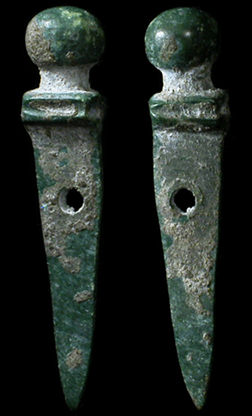
Roman bronze flagellum or scourge (Cat 'o' Nine Tails) punishment instrument. 1st-4th century AD. One piece from the end of a leather whip used to inflict punishment upon soldiers when they acted against orders. A fascinating piece of history. 28 mm max diameter. Some barbs broken in antiquity, possibly from extensive use. This would account for it having been discarded (and replaced). Found in a Roman trash-pit near a Legionary encampment in Eastern Europe. #6680: $225 SOLD

Roman bronze flagellum or scourge (Cat 'o' Nine Tails) punishment instrument. 1st-4th century AD. One piece from the end of a leather whip used to inflict punishment upon soldiers when they acted against orders. A fascinating piece of history. Very large and intimidating specimen at 28x12 mm (1 1/8" x 1/2"). Barbs worn in antiquity, likely from extensive use. Great olive-green patina. Found in a Roman trash-pit near a Legionary encampment in northern Britain. #23726: $399 SOLD
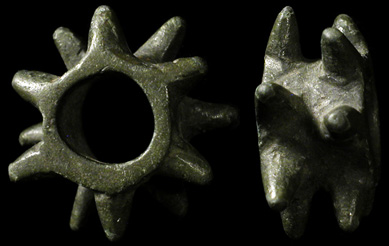
Roman bronze flagellum or scourge (Cat 'o' Nine Tails) punishment instrument. 1st-4th century AD. One piece from the end of a leather whip used to inflict punishment upon soldiers when they acted against orders. A fascinating piece of history. 26x11 mm (1" x 3/8"). Barbs worn in antiquity, likely from extensive use. Found in a Roman trash-pit near a Legionary encampment in Eastern Europe. #76392: $299 SOLD
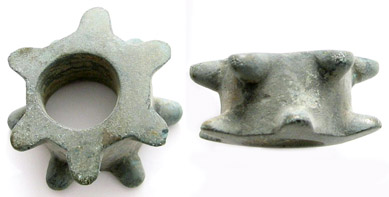
Roman bronze flagellum or scourge (Cat 'o' Nine Tails) punishment instrument. 1st-4th century AD. One piece from the end of a leather whip used to inflict punishment upon soldiers when they acted against orders. A fascinating piece of history. 30x9 mm (1 3/16" x 3/8"). Nice light green patina. Barbs worn in antiquity, likely from extensive use. Tip of one barb broken off in antiquity. Found near a Legionary encampment in northern Britain. #23725: $399 SOLD

Roman bronze flagellum or scourge (Cat 'o' Nine Tails) punishment instrument. 1st-4th century AD. One piece from the end of a leather whip used to inflict punishment upon soldiers when they acted against orders. A fascinating piece of history. Barbs worn in antiquity, likely from extensive use. Found near a Legionary encampment bear the Danube River, Eastern Europe. 28x12 mm. Gorgeous black patina with earthen deposits. #59575: $399 SOLD
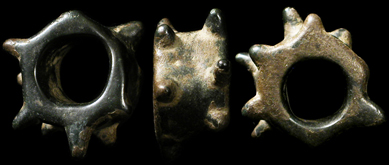
Ancient Rome, 1st-3rd century AD. Small Roman bronze gladius / sword amulet. A gorgeous example, basically a perfect miniature of the original! Nice light green patina with earthen highlights. A Legionary or possibly a gladiator relic! 28 mm long. #18056: $275 SOLD
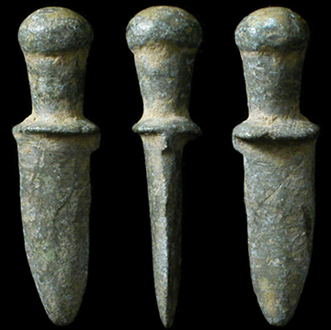
Roman Gladius Amulet
Ancient Rome, 1st-3rd century AD. Small Roman bronze gladius / sword amulet. One of the most attractive and desirable ancient amulets. Issued to a soldier wounded in combat, much like a modern-day "purple heart" medal. The hole through the blade is representitive of a hole in the body. "I may have a hole in my body but I shall fight on." Ding on edge of blade may have some significance in addition to the hole itself, likely to indicate "damage" in combat. 33 mm (1 5/16") with great light green patina. Cf. Benet R99-0104. ex-German private collection. #AR2276: $250 SOLD
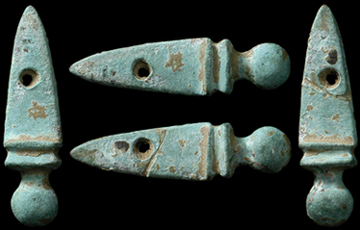
Roman bronze soldier's military diploma fragment! 1st-3rd century AD. Exceedingly rare! Actually 2 pieces broken from the same diploma. A beautiful piece, with Latin inscriptions clearly visible on both sides. Found at an ancient site in former Thrace/Macedonia. A military diploma was a permanent document issued by Rome to a soldier or praetorian upon retirement, which detailed his service and the various rights now granted to him. This document would have been the single most important item to a retired Roman soldier! Ex- Midwest scholastic collection. Pieced together, the entire artifact measures 35 mm (1 3/8") end to end, with a great olive green patina. #20491: $575 SOLD

Ancient Rome, 1st-3rd century AD. Small Roman bronze gladius / sword amulet. One of the most attractive and desirable ancient amulets. Issued to a soldier wounded in combat, much like a modern-day "purple heart" medal. The hole through the blade is representitive of a hole in the body. "I may have a hole in my body but I shall fight on." Ding on edge of blade may have some significance in addition to the hole itself, likely to indicate "damage" in combat. Cf. Benet R99-0104. 22 mm (15/16") long. #17513: $225 SOLD
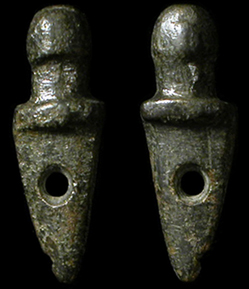
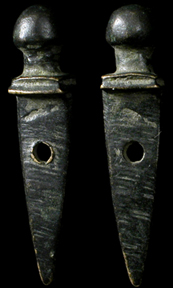
Ancient Rome, 1st-3rd century AD. Roman bronze gladius / sword amulet. One of the most attractive and desirable ancient amulets. Issued to a soldier wounded in combat, much like a modern-day "purple heart" medal. The hole through the blade is representitive of a hole in the body. "I may have a hole in my body but I shall fight on." Large 40 mm (1 1/2") with great deep green patina with light earthen deposits. Cf. Benet R99-0104. ex-German private collection. #AR2438: $275 SOLD - Ask about alternates!
 Ancient Rome, 1st-3rd century AD. Small Roman bronze gladius / sword amulet. One of the most attractive and desirable ancient amulets. Issued to a soldier wounded in combat, much like a modern-day "purple heart" medal. The hole in the blade is representitive of a hole in the body. "I may have a hole in my body but I shall fight on." 28 mm (1 1/8") with light olive-green patina. Cf. Benet R99-0104. ex-London, UK gallery. #AR2784: $250 SOLD
Ancient Rome, 1st-3rd century AD. Small Roman bronze gladius / sword amulet. One of the most attractive and desirable ancient amulets. Issued to a soldier wounded in combat, much like a modern-day "purple heart" medal. The hole in the blade is representitive of a hole in the body. "I may have a hole in my body but I shall fight on." 28 mm (1 1/8") with light olive-green patina. Cf. Benet R99-0104. ex-London, UK gallery. #AR2784: $250 SOLD
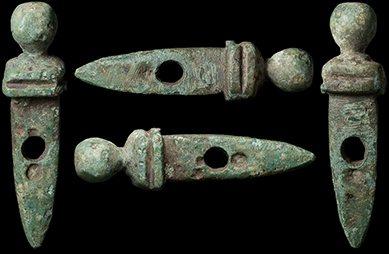
Ancient Rome, 1st-3rd century AD. Nice Roman bronze gladius / sword amulet. One of the most attractive and desirable ancient amulets. Issued to a soldier wounded in combat, much like a modern-day "purple heart" medal. The hole through the blade is representitive of a hole in the body. "I may have a hole in my body but I shall fight on." 33 mm (1 5/16") with great olive-green patina. Cf. Benet R99-0104. ex-London, UK gallery. #AR2765: $350 SOLD

Ancient Rome, 1st-3rd century AD. Nice Roman bronze gladius / sword amulet. One of the most attractive and desirable ancient amulets. Issued to a soldier wounded in combat, much like a modern-day "purple heart" medal. The hole through the blade is representitive of a hole in the body. "I may have a hole in my body but I shall fight on." 34 mm (1 5/16") with deep olive-green patina. Cf. Benet R99-0104. ex-London, UK gallery. #AR2767: $299 SOLD
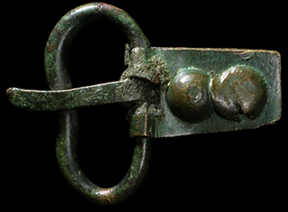 Ancient Roman, c. 4th-5th century AD. Gorgeous bronze military / legionary buckle. Used on soldiers' armor and military fittings. Rectangular-plate type, with 2 chunky attachment rivets. 1 7/8" (48 mm). Gorgeous glossy green patina, loop and pin fused in place. #AR2439: $175 SOLD
Ancient Roman, c. 4th-5th century AD. Gorgeous bronze military / legionary buckle. Used on soldiers' armor and military fittings. Rectangular-plate type, with 2 chunky attachment rivets. 1 7/8" (48 mm). Gorgeous glossy green patina, loop and pin fused in place. #AR2439: $175 SOLD
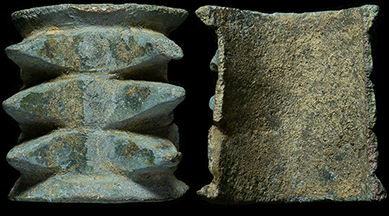 Ancient Roman Legionnaire's Brass Knuckles!
Ancient Roman Legionnaire's Brass Knuckles!
Ancient Rome, c. 1st-3rd century AD. Also called a "punch-ring", it is a spiked/knobbed bronze ring worn to intensify a punch during hand-to-hand combat. Broken in antiquity. Nicely preserved, with olive-green patina with earthen deposits. H: 30 mm (1 3/16"). #AR2474: $250 SOLD
 Roman North Africa, c. 3rd-5th century AD. Excellent redware plate fragment depicting a Roman soldier holding a spear. Finely executed details in the hair and face, his cuirass (armor) clearly visible. Large 62x54 mm (2 1/2" x 2") and very thick. Philadelphia, PA private collection. #AR2422: $350 SOLD
Roman North Africa, c. 3rd-5th century AD. Excellent redware plate fragment depicting a Roman soldier holding a spear. Finely executed details in the hair and face, his cuirass (armor) clearly visible. Large 62x54 mm (2 1/2" x 2") and very thick. Philadelphia, PA private collection. #AR2422: $350 SOLD
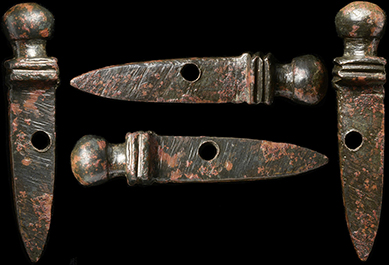 Ancient Rome, 1st-3rd century AD. Absolutely incredible Roman bronze gladius / sword amulet. One of the most attractive and desirable ancient amulets. Issued to a soldier wounded in combat, much like a modern-day "purple heart" medal. The hole through the blade is representitive of a hole in the body. "I may have a hole in my body but I shall fight on." Very large 46 mm (1 13/16") with glossy olive-green to reddish patina. Cf. Benet R99-0104. ex-Malte Carsten Roehner collection, Heilbronn, Germany. A magnificent, museum-quality example! By far the best I have ever had. #AR2781: $750 SOLD
Ancient Rome, 1st-3rd century AD. Absolutely incredible Roman bronze gladius / sword amulet. One of the most attractive and desirable ancient amulets. Issued to a soldier wounded in combat, much like a modern-day "purple heart" medal. The hole through the blade is representitive of a hole in the body. "I may have a hole in my body but I shall fight on." Very large 46 mm (1 13/16") with glossy olive-green to reddish patina. Cf. Benet R99-0104. ex-Malte Carsten Roehner collection, Heilbronn, Germany. A magnificent, museum-quality example! By far the best I have ever had. #AR2781: $750 SOLD
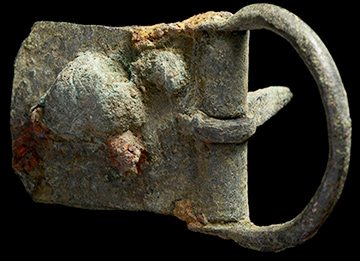 Roman bronze lorica segmentata. 1st-2nd century AD. A nice piece of Lorica Segmentata strap buckle for Corbridge armor... the earliest Roman form of segmented plate armor. Intact with the original front rivet still holding the pin and loop together; the loop and pin fused in place at a 90-degree angle. 38 mm (1 1/2") long. Olive green patina, heavy earthen deposits. ex-UK collection. #AR2571: $125 SOLD
Roman bronze lorica segmentata. 1st-2nd century AD. A nice piece of Lorica Segmentata strap buckle for Corbridge armor... the earliest Roman form of segmented plate armor. Intact with the original front rivet still holding the pin and loop together; the loop and pin fused in place at a 90-degree angle. 38 mm (1 1/2") long. Olive green patina, heavy earthen deposits. ex-UK collection. #AR2571: $125 SOLD
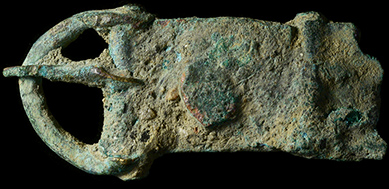 Roman bronze lorica segmentata. 1st-2nd century AD. A nice piece of Lorica Segmentata strap buckle for Corbridge armor... the earliest Roman form of segmented plate armor. Intact with the original front rivet still holding the pin and loop together; the loop and pin fused in place. 43 mm (1 3/4") long. Olive green patina, heavy earthen deposits. ex-UK collection. #AR2572: $125 SOLD
Roman bronze lorica segmentata. 1st-2nd century AD. A nice piece of Lorica Segmentata strap buckle for Corbridge armor... the earliest Roman form of segmented plate armor. Intact with the original front rivet still holding the pin and loop together; the loop and pin fused in place. 43 mm (1 3/4") long. Olive green patina, heavy earthen deposits. ex-UK collection. #AR2572: $125 SOLD
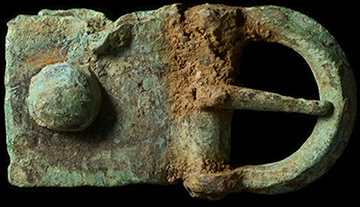 Roman bronze lorica segmentata. 1st-2nd century AD. A nice piece of Lorica Segmentata strap buckle for Corbridge armor... the earliest Roman form of segmented plate armor. Intact with the original front rivet still holding the pin and loop together; the loop and pin fused in place. 31 mm (1 1/4") long. Olive green patina, earthen deposits. ex-UK collection. #AR2568: $150 SOLD
Roman bronze lorica segmentata. 1st-2nd century AD. A nice piece of Lorica Segmentata strap buckle for Corbridge armor... the earliest Roman form of segmented plate armor. Intact with the original front rivet still holding the pin and loop together; the loop and pin fused in place. 31 mm (1 1/4") long. Olive green patina, earthen deposits. ex-UK collection. #AR2568: $150 SOLD
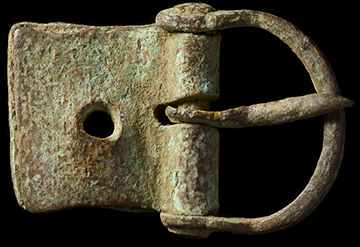 Roman bronze lorica segmentata. 1st-2nd century AD. A nicely articulated Lorica Segmentata strap buckle for Corbridge armor... the earliest Roman form of segmented plate armor. Intact with the original front rivet still holding the pin and loop together; the loop still moves freely but the pin fused in place. 28 mm (1 1/8") long. Olive green patina, earthen deposits. ex-UK collection. #AR2570: $150 SOLD
Roman bronze lorica segmentata. 1st-2nd century AD. A nicely articulated Lorica Segmentata strap buckle for Corbridge armor... the earliest Roman form of segmented plate armor. Intact with the original front rivet still holding the pin and loop together; the loop still moves freely but the pin fused in place. 28 mm (1 1/8") long. Olive green patina, earthen deposits. ex-UK collection. #AR2570: $150 SOLD
 Roman bronze lorica segmentata. 1st-2nd century AD. A fully articulated Lorica Segmentata strap buckle for Corbridge armor... the earliest Roman form of segmented plate armor. Intact with the original front rivet still holding the pin and loop together; the pin still moves freely. 38 mm (1 1/2") long. Olive green patina, light earthen deposits. ex-UK collection. #AR2565: $250 SOLD
Roman bronze lorica segmentata. 1st-2nd century AD. A fully articulated Lorica Segmentata strap buckle for Corbridge armor... the earliest Roman form of segmented plate armor. Intact with the original front rivet still holding the pin and loop together; the pin still moves freely. 38 mm (1 1/2") long. Olive green patina, light earthen deposits. ex-UK collection. #AR2565: $250 SOLD
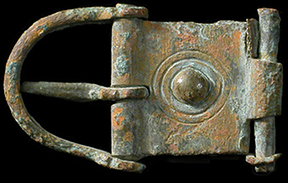 Roman bronze lorica segmentata. 1st-2nd century AD. A nicely articulated Lorica Segmentata strap buckle for Corbridge armor... the earliest Roman form of segmented plate armor. Intact with the original front rivet still holding the pin and loop together; the loop still moves freely but the pin fused in placce. 33 mm (1 5/16") long. Great brassy to olive green patina, earthen deposits. ex-UK collection. #AR2567: $225 SOLD
Roman bronze lorica segmentata. 1st-2nd century AD. A nicely articulated Lorica Segmentata strap buckle for Corbridge armor... the earliest Roman form of segmented plate armor. Intact with the original front rivet still holding the pin and loop together; the loop still moves freely but the pin fused in placce. 33 mm (1 5/16") long. Great brassy to olive green patina, earthen deposits. ex-UK collection. #AR2567: $225 SOLD
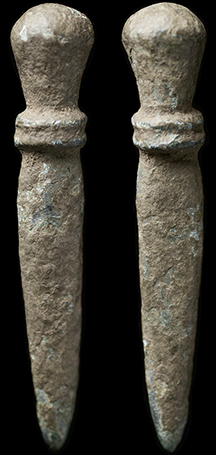 Ancient Rome, 1st-3rd century AD. Nice Roman bronze gladius / sword amulet. One of the most desirable ancient Roman military amulets. Long, slender form with rounded pommel. 36 mm (1 3/8") with light green patina, light earthen deposits. Cf. Benet R99-0104. ex-London, UK gallery. #AR2806: $225 SOLD
Ancient Rome, 1st-3rd century AD. Nice Roman bronze gladius / sword amulet. One of the most desirable ancient Roman military amulets. Long, slender form with rounded pommel. 36 mm (1 3/8") with light green patina, light earthen deposits. Cf. Benet R99-0104. ex-London, UK gallery. #AR2806: $225 SOLD
 Ancient Rome, 1st-3rd century AD. Small Roman bronze gladius / sword amulet. One of the most attractive and desirable ancient amulets. Issued to a soldier wounded in combat, much like a modern-day "purple heart" medal. The hole in the blade is representitive of a hole in the body. "I may have a hole in my body but I shall fight on." 24 mm (15/16") with dark olive-green patina. Cf. Benet R99-0104. ex-London, UK gallery. #AR2996: $299
Ancient Rome, 1st-3rd century AD. Small Roman bronze gladius / sword amulet. One of the most attractive and desirable ancient amulets. Issued to a soldier wounded in combat, much like a modern-day "purple heart" medal. The hole in the blade is representitive of a hole in the body. "I may have a hole in my body but I shall fight on." 24 mm (15/16") with dark olive-green patina. Cf. Benet R99-0104. ex-London, UK gallery. #AR2996: $299
SOLD - Ask about alternates!
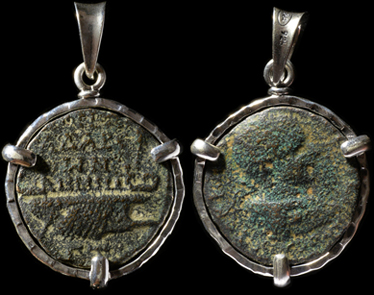 Ancient Rome. Gordian III, 238-244 AD. Large bronze coin of Gadara, Syria, set into stunning custom silver bezel.
Ancient Rome. Gordian III, 238-244 AD. Large bronze coin of Gadara, Syria, set into stunning custom silver bezel.
Dated Year 303 239-240 AD). His laureate, draped, & cuirassed bust rt., AVTOK K M ANT GORDIANOC CEB / Roman galley (ship) right with eight oarsmen, a helmsman, and a soldier holding signum standing on prow; date GT below, POMP GADAWN. 28 mm diameter. ref: Spijkerman 93; Rosenberger 90. Olive green patina, earthen deposits. Huge, thick and heavy coin. Great ship! Better than photo portrays. #CR2302: $299 SOLD
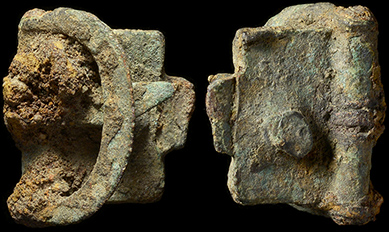 Roman bronze lorica segmentata. 1st-2nd century AD. A nice piece of Lorica Segmentata strap buckle for Corbridge armor... the earliest Roman form of segmented plate armor. The original front rivet still holding the pin and loop together; the loop and pin fused in place. W: 19 mm (3/4"). Olive green patina, heavy earthen deposits. ex-UK collection. #AR2569: $125 SOLD
Roman bronze lorica segmentata. 1st-2nd century AD. A nice piece of Lorica Segmentata strap buckle for Corbridge armor... the earliest Roman form of segmented plate armor. The original front rivet still holding the pin and loop together; the loop and pin fused in place. W: 19 mm (3/4"). Olive green patina, heavy earthen deposits. ex-UK collection. #AR2569: $125 SOLD
 Ancient Roman, c. 4th-5th century AD. Gorgeous bronze military / legionary buckle. Used on soldiers' armor and military fittings. Triangular-plate type, with nicely decorated surfaces and 2 small attachment rivets. Cf. Appels & Laycock SL10.20-27. 2 1/4" (58 mm) with beautiful bluish-green patina. Hinge, loop and pin all move freely. A great piece! #AR2440: $225 SOLD
Ancient Roman, c. 4th-5th century AD. Gorgeous bronze military / legionary buckle. Used on soldiers' armor and military fittings. Triangular-plate type, with nicely decorated surfaces and 2 small attachment rivets. Cf. Appels & Laycock SL10.20-27. 2 1/4" (58 mm) with beautiful bluish-green patina. Hinge, loop and pin all move freely. A great piece! #AR2440: $225 SOLD
Rare Roman Diploma Fragment
 Ancient Rome, c. 2nd century AD. Fantastic bronze military diploma fragment. Both sides with Latin inscriptions commemorating a soldier or Legionaire's completion of his military duties. One side 'A LSSO', the other with 'AVGI / II / VERV / AN'. 20x15mm (3/4" x 5/8"). Fine condition with dark olive-green patina. Ex London, England collection, acquired in the late 1960s-early 1970s. #AR3117: $650 SOLD
Ancient Rome, c. 2nd century AD. Fantastic bronze military diploma fragment. Both sides with Latin inscriptions commemorating a soldier or Legionaire's completion of his military duties. One side 'A LSSO', the other with 'AVGI / II / VERV / AN'. 20x15mm (3/4" x 5/8"). Fine condition with dark olive-green patina. Ex London, England collection, acquired in the late 1960s-early 1970s. #AR3117: $650 SOLD
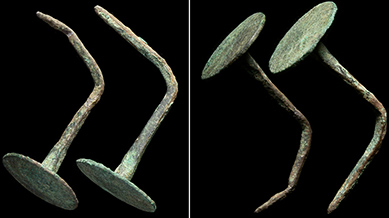 Ancient Roman, c. 1st-3rd century AD. Pair of nice and very rare hob nails! These were the nails used on the soles of Roman military sandals and boots. Each about 1 inch long, with nice green patina. Ex Los Angeles private collection. Rare! #AR2686: $150 SOLD
Ancient Roman, c. 1st-3rd century AD. Pair of nice and very rare hob nails! These were the nails used on the soles of Roman military sandals and boots. Each about 1 inch long, with nice green patina. Ex Los Angeles private collection. Rare! #AR2686: $150 SOLD
Roman "Scourge" or "Cat o' Nine Tails"
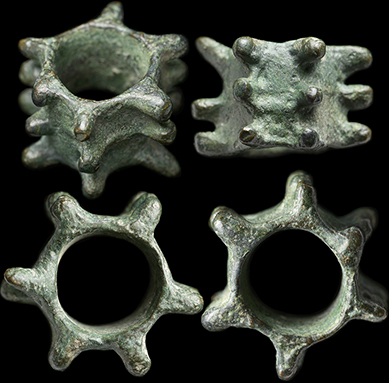 A very large Roman bronze flagellum or scourge (Cat 'o' Nine Tails) punishment instrument. 1st-4th century AD. One piece from the end of a leather whip used to inflict punishment upon soldiers when they acted against orders. A fascinating piece of history. With six rows of three radiating spikes to the outer face... some barbs worn in antiquity, likely from extensive use. 30mm (1") diameter, 20mm thick. Fine condition, dark olive-green patina. Provenance: From an East London collector; previously in a collection formed between 1990-2000. #AR3122: $450 SOLD
A very large Roman bronze flagellum or scourge (Cat 'o' Nine Tails) punishment instrument. 1st-4th century AD. One piece from the end of a leather whip used to inflict punishment upon soldiers when they acted against orders. A fascinating piece of history. With six rows of three radiating spikes to the outer face... some barbs worn in antiquity, likely from extensive use. 30mm (1") diameter, 20mm thick. Fine condition, dark olive-green patina. Provenance: From an East London collector; previously in a collection formed between 1990-2000. #AR3122: $450 SOLD
 Ancient Roman, c. 1st-3rd century AD. Nice bronze Legionary toggle, a fastener for a military cloak called a paenula. This toggle was made resembling a palisade stake used by Roman soldiers to construct encampments and fortifications. Ref: Appels & Laycock, Roman Buckles & Military Fittings, p. 145, Fig. AA15.40 for exact type. Ex Los Angeles, CA private collection. #AR3387: $225 SOLD
Ancient Roman, c. 1st-3rd century AD. Nice bronze Legionary toggle, a fastener for a military cloak called a paenula. This toggle was made resembling a palisade stake used by Roman soldiers to construct encampments and fortifications. Ref: Appels & Laycock, Roman Buckles & Military Fittings, p. 145, Fig. AA15.40 for exact type. Ex Los Angeles, CA private collection. #AR3387: $225 SOLD
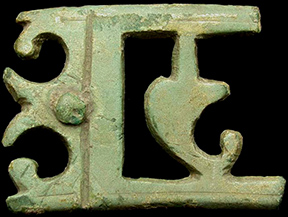 Roman Legionary, 1st-2nd Century AD. A Roman Legionary bronze openwork belt plate fragment. Originally cast-made, but broken in antiquity, perhaps 1/3 of the original artifact represented here. W: 28mm, excellent light olive-green patina, light earthen deposits. Ref: Appels & Laycock, Roman Buckles & Military Fittings, pp 72-74 for type. Ex Sandes collection, Southern California. #AR3437: $125 SOLD
Roman Legionary, 1st-2nd Century AD. A Roman Legionary bronze openwork belt plate fragment. Originally cast-made, but broken in antiquity, perhaps 1/3 of the original artifact represented here. W: 28mm, excellent light olive-green patina, light earthen deposits. Ref: Appels & Laycock, Roman Buckles & Military Fittings, pp 72-74 for type. Ex Sandes collection, Southern California. #AR3437: $125 SOLD
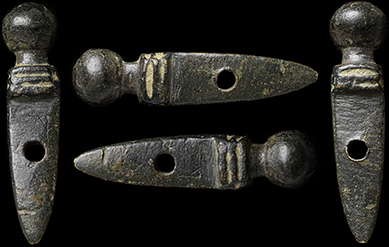
Ancient Rome, 1st-3rd century AD. Excellent Roman bronze gladius / sword amulet. One of the most attractive and desirable ancient amulets. Issued to a soldier wounded in combat, much like a modern-day "purple heart" medal. The hole through the blade is representative of a hole in the body. "I may have a hole in my body but I shall fight on." 35 mm (1 3/8”) with glossy dark olive-green patina. Cf. Benet R99-0104 for type. ex-Los Angeles, CA collection. A museum-quality example! One of the nicest of these I’ve ever had. #AR3277: $399 SOLD - Others available!
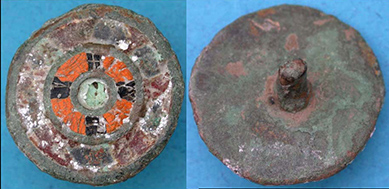 Fantastic Roman Legionary Harness Mount, 2nd Century AD. A round bronze Legionary mount with fine enameled details. Very nicely preserved, cleaned and waxed with much of the original red, black, orange & green enameling intact. 21mm diameter. For parallels see Herma Stiglitz' article "Auxiliarkastell-Carnuntm", fig.4, #11, in Carnuntum Jahrbuch 1986. A similar horse harness mount was found in the auxiliary fort at Carnuntum, which was used by the Roman cavalry unit Ala I Thracum in the 2nd century AD. Ex Sandes collection, Southern California. * I can provide a better "in hand" photo upon request. #AR3434: $275 SOLD
Fantastic Roman Legionary Harness Mount, 2nd Century AD. A round bronze Legionary mount with fine enameled details. Very nicely preserved, cleaned and waxed with much of the original red, black, orange & green enameling intact. 21mm diameter. For parallels see Herma Stiglitz' article "Auxiliarkastell-Carnuntm", fig.4, #11, in Carnuntum Jahrbuch 1986. A similar horse harness mount was found in the auxiliary fort at Carnuntum, which was used by the Roman cavalry unit Ala I Thracum in the 2nd century AD. Ex Sandes collection, Southern California. * I can provide a better "in hand" photo upon request. #AR3434: $275 SOLD
|
|
|






























































































